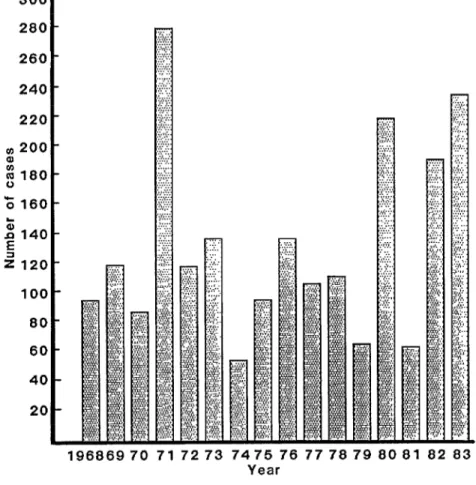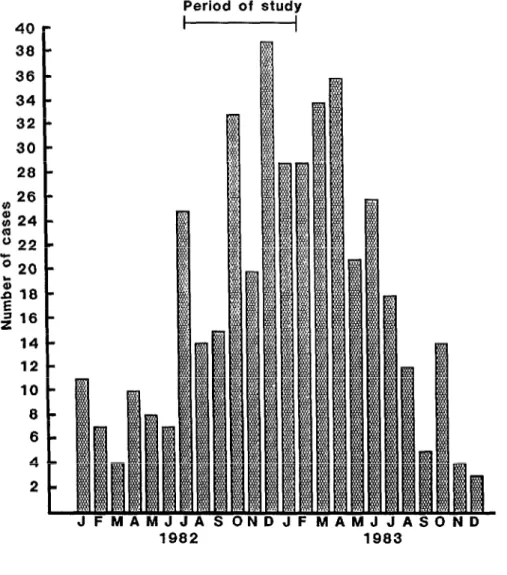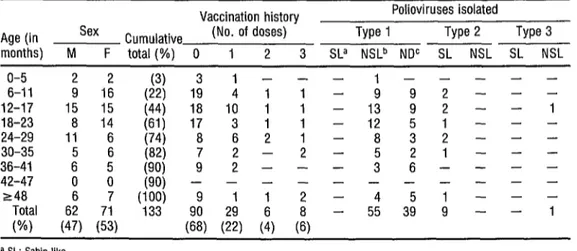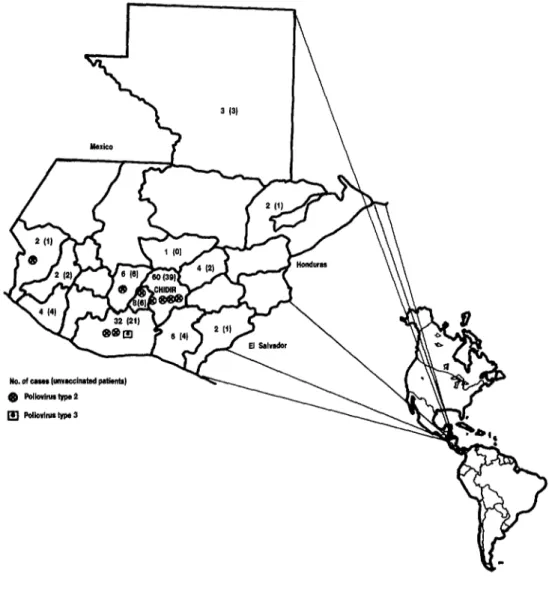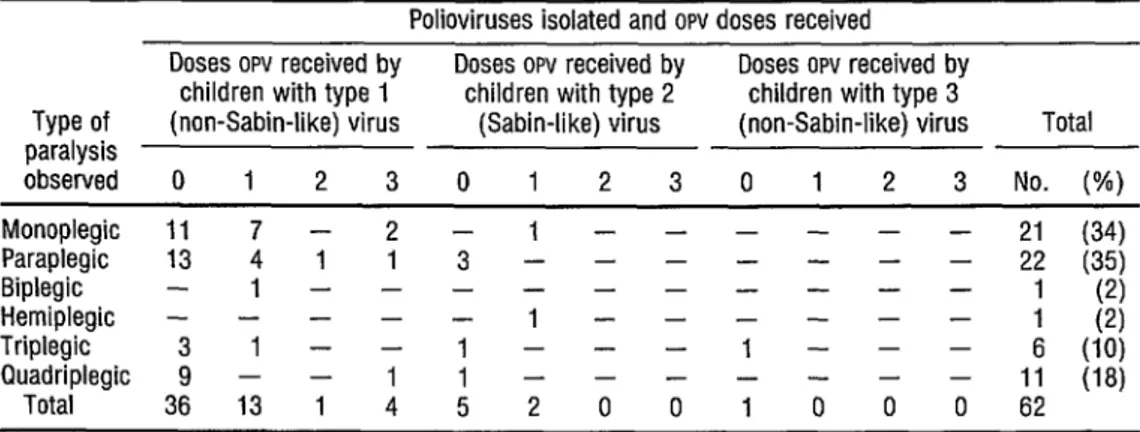P
ARALYTIC
POLIOMYELITIS IN GUATEMALA1
J. R. Cwq2 M. A. Monterros~,~ 0. A. Zeis~ig,~
A. G. Hazendonk,5 andA. L. Van WezeP
I
NTRODUCTION
Paralytic poliomyelitis has
been controlled in various developed areas of the world with the help of either inactivated or live oral vaccines (l-3).
However, despite massive vaccination campaigns, the disease continues to pose a serious health problem in tropical countries (4, j). Such is the situation in Guatemala, where oral polio vaccine
(OPV) has been used since 1973. Analy- sis of the number of paralytic poliomye- litis cases admitted in recent years to the Children’s Hospital for Infectious Dis- eases and Rehabilitation (CHIDIR), the
national referral center in Guatemala City, shows that the disease continues to be endemic and that increased numbers of admissions have occurred periodically
r This article will also be published in Spanish in the k Bolettir de /a O$cina Sanitaria Panameticana, vol. 2
103, 1987. PAHO provided partial financial support for the virologic studies reported here. Reprint re- .
3
quests should be addressed to J. R. Cruz, Program of F;
Infection, Nutrition, and Immunology; Division of Nutrition and Health; INCAP; P.O. Box 1188, Guate- .g mala City, Guatemala.
QJ
a * Chief, Program of Infection, Nutrition, and Immu- * nology; Division of Nutrition and Health; Institute of
2
Nutrition of Central America and Panama (INAP);
Guatemala City, Guatemala. 2
3 Research Assistant, Program of Infection, Nutrition, a, 4 Chief, Division of Epidemiology, Ministry of Public and Immunology, INCAP.
Health, Guatemala City, Guatemala.
262 s Rijksinstituut pi&e, the Netherlands. voor Volksgezondheid en Milieuhy-
(Figure 1) (G). Starting in July 1982, the number of patients with signs and symptoms of paralytic poliomyelitis ad- mitted to the CHIDIR increased sharply
(Figure 2), prompting the investigation reported here.
P
ATIENTS STUDIED AND
VIROLOGIC METHODS
One hundred and thirty-
three children with clinical diagnoses of paralytic poliomyelitis were studied. All were admitted to the CHIDIR between 15
July 1982 and 31 January 1983. Each child’s age, sex, place of residence, clin- ical symptoms, and history of vaccina- tion with oral polio vaccine (OPV) were
recorded.
Fecal specimens for po- liovirus isolation were obtained on the day of admission by means of a rectal swab. The fecal material was placed in cold Earle’s balanced salt solution sup- plemented with penicillin and strepto- mycin and was transported to INCAP’S~
FIGURE 1. The number of children with paralytic poliomyelitis admitted to the Children’s Hospital for Infectious Diseases and Rehabilitation (CHIDIR) in Guatemala City from 1968
through 1983, by year. 300
280 260 240
Q 200 al ; 180 ;s 160
z : 140 &20
100 80 60 40 20
19686970 717273 7475 76 777879808182 83 Year
central laboratories on wet ice. After ap-
propriate centrifugation and further
treatment with antibiotics, the speci- mens were inoculated into monolayers
of HEp-2 cells (M.A. Bioproducts,
Maryland, USA) and fed with Eagle’s minimal essential medium with Earle’s salts and fetal bovine serum. The cell cultures were monitored microscopically
for a maximum of 14 days to detect the appearance of cytopathic effects. Once cytopathic effects were detected, the iso- lates were identified as polioviruses by neutralization test (NT), using pooled antisera against the three poliovirus se- rotypes. Typing was accomplished using monospecific antisera. Sixty-six of the isolates were shipped in dry ice from Guatemala to Holland, where a deter- mination as to whether the isolate was Sabin-like (SL) or non-Sabin-like (NSL)
FIGURE 2. The number of children with paralytic poliomyelitis admitted monthly to the CHIDIR in 1982-1983.
40 - 38 - 36 - 34 - 32 - 30 - 28 *
2 26 - $24 - 022 - ;20 -
z I8 2 16 -
14 - 12 - 10 - 8 - 6 - 4 - 2 -
Period of study
I I
1982 1983
I
-
3
G
RE
SULTS
not received any OPV. However, eight$ (6%) were reported to have received
Q ;i Study Patient Characteristics three doses (Table 1). Most of the sub-
2 The age of the patients stud-
jects (45 %) lived in Guatemala Depart-
ied ranged from four months to five ment or in the six departments adjacent
3 years, with 58% being 6-23 months
to it (44%) (Figure 3).
old. Seventy-one were girls and 62 were boys, creating a female: male ratio of
TABLE 1. The study children’s age, sex, and vaccination history, and the types of Sabin-like and non-Sabin- like polioviruses isolated from them.
Age (in
Vaccination history Polioviruses isolated
Sex Cumulative (No. of doses) Type 1 Type 2 Type 3 months) M F total(%) 0 1 2 3 SLa NSLb NDC SL NSL SL NSL
O-5 2 (3) 3 l- -- I- - --- 6-11 9
1:
19 4 1 1 - 9 9 2 - - 12-17 15 15 y; 18 10 1 1 - 13 9 2 - - ; 18-23 14 (61) 17 3 1 - 12 5 1 - - - 24-29 1: 6 i-832---
30-35 - - -
36-41
42-47 0 0
248 6 7 (100) 9 11 2 - 4 5 1 - - - Total 62 71 133 90 29 6 8 - 55 39 9 - - 1 W) (47) (53) (68) (22) (4) (6)
a SL: Sabin-like. b NSL: Non-Sabin-like. c ND: Not determined.
Poliovirus Isolation Clinical Manifestations
One hundred and four chil- The basic types of paralysis
dren (78%) were found to be excreting viruses at the time of admission to the
CHIDIR; only two of the isolates ob-
tained were not polioviruses. Ninety- two (90 %) of the excreters shed only po- liovirus type 1; seven excreters (7%) shed only poliovirus type 2; one shed only poliovirus type 3; and two shed both type 1 and type 2.
Intratypic Differentiation
Sixty-six viral strains were subjected to serodifferentiation into Sabin-like and non-Sabin-like strains. Fifty-five of the 56 type 1 isolates and the lone type 3 isolate were classified as non-Sabin-like. The remaining type 1 isolate could not be classified as either Sabin-like or non-Sabin-like. All nine type 2 isolates were Sabin-like.
observed among the 62 children from whom only one type of poliovirus was
isolated are shown in Table 2. Twenty- one children (34%) exhibited paralysis of one leg, 22 (35%) had paraplegia, one (2%) had biplegia, one had hemi- plegia, six (10 %) had triplegia, and 11
(18 %) had quadriplegia. The child with biplegia, a three-year-old boy, was af- fected in the right arm and left leg. The child with hemiplegia (left hemiplegia) was 28 months old. Two of the children from whom non-Sabin-like poliovirus type 1 was isolated died.
D
ISCUSSIONFIGURE 3. Geographic distribution of the study children, showing the number of these children in each de- partment, the number unvaccinated against poliomyelitis (in parentheses), the number found infected with Sabin-like type 2 polioviruses, and the single child found infected with type 3 poliovirus.
.
s
s
.g mitted to the CHIDIR in Guatemala in
Q
Q 1984, 1985 and 1986, respectively (8).
;Y
:
The first 39 cases reported in 1986 con-
stituted 13% of those in the Americas outside Brazil and 4 % of those reported
266
in the entire Western Hemisphere for 1986. (9).
Most of the 1982 patients (61%) were less than two years old, a proportion similar to that observed in a 1982 epidemic on Taiwan (10). Ninety
TABLE 2. Types of paralysis observed among the 62 children from whom one type of poliovirus was isolated and classified as a Sabin-like or non-Sabin-like strain, by the type of virus isolated and the child’s vaccination history.
Polioviruses isolated and OPV doses received Doses OPV received by Doses OPV received by Doses OPV received by
children with type 1 children with type 2 children with type 3
Type of (non-Sabin-like) virus (Sabin-like) virus (non-Sabin-like) virus Total paralysis
observed 0 1 2 3 0 1 2 3 0 1 2 3 No. (%) Monoplegic 11 7 - 2 - 1 - - - 21 (34) Paraplegic 13 4 1 1 3 - - - 22 (35)
Biplegic _ 1 - _ _ - - _ _ _ - - 1 (2) Hemiplegic _ - _ _ - 1 _ _ - _ _ _
Triplegic 31--q---f--- A (1’:; Quadriplegic 9 - - 1 1 - - - 11 (18)
Total 36 13 1 4 5 2 0 0 1 0 0 0 62
during the first six months of life. At the same time, the noteworthy numbers of vaccinated children from whom po- hoviruses were isolated suggests a failure by the Sabin OPV used to provide lasting immunity.
Acute-phase sera from the eight children with a history of receiving three OPV doses were tested for the pres- ence of antipolio neutralizing antibod- ies, and none of them was found to be positive. Although these children may simply represent the proportion of all children known not to seroconvert after appropriate vaccination (II), it is also
possible that the vaccines administered had lost their potency due to improper handling. Appropriate quality control of the vaccines involved and subsequent assessment of the vaccinees’ seroconver- sion would help to determine the factors responsible for this failure to induce protection.
Most of the polioviruses iso- lated were type 1; only one out of the 104 strains was type 3. This finding agrees with the prevalence of type 1
cases reported from other parts of the world around the 1982 period (2, 10,
12, 13). Interestingly enough, all of the
type 1 and type 3 isolates that could be
classified by ELISA as Sabin-like or non- Sabin-like were found to be non-sabin- like (wild-type) viruses. Control of wild- type virus transmission would therefore result in a dramatic decrease in poliomy- elitis morbidity.
On the other hand, all nine type 2 isolates were found to be Sabin-
like strains. Six of the children from whom these strains were isolated had never received OPV; the remaining three
were given OPV at five, 12, and 14 months before their symptoms began. Furthermore, no recent contact with vaccine recipients was reported for any of the children.
living in five different departments of Guatemala, four of which are situated very close to one another (Figure 3). There thus seems no reason to exclude the possibility that the genetically un- stable type 2 vaccine strain could have reverted to a virulent form after multi- ple cycles of natural transmission, and could have caused a small epidemic in undervaccinated children. The other two Sabin-like type 2 strains were iso- lated during the late phase of the study and were found in combination with type 1. Since serologic determinations were not made with acute and convales- cent sera, it is impossible to determine which of the two types of virus was re- sponsible for the disease in these two pa- tients. Nevertheless, it is apparent that the 1982-1983 epidemic was associated with type 1 non-Sabin-like poliovirus.
A high degree of fecal con- tamination and low levels of hygiene are associated with the poor sewage disposal and potable water distribution systems prevalent in Guatemala, and all of this plays an important role in the high inci- dence of poliomyelitis. Nevertheless, appropriate measures to control the transmission of wild-type polioviruses would cause a drastic drop in the num- ber of paralytic poliomyelitis cases oc- curring among Guatemalan children. Such activities should include quality control of the vaccines (starting when k they are received by the health authori- 2 ties) as well as continued surveillance of
.
3 cases and of the viruses associated with
s the disease.
S
UMMARYchildren were admitted to the Chil- dren’s Hospital for Infectious Diseases and Rehabilitation (CHIDIR) in Guate- mala City between 15 July 1982 and 3 1 January 1983.
One hundred and four chil- dren (78%) were shown to be excreting viruses in their feces at the time of ad- mission; all but two of the isolates were polioviruses. Ninety-two (90%) of the excreters shed type 1 poliovirus only, seven shed type 2 only, one shed type 3 only, and two shed both types 1 and 2. Sixty-six viral isolates were tested to de- termine whether they were Sabin-like or non-Sabin-like strains. Fifty-five of 56 type 1 isolates and the only type 3 iso- late were found to be non-Sabin-like. The remaining type 1 isolate could not be classified. All nine of the type 2 iso- lates were Sabin-like.
Ninety of the 133 afflicted children (68 % ) had no history of receiv- ing oral poliovirus vaccine, 29 (22 % ) apparently received one dose, six (4%) had reportedly received two doses, and eight (6%) were said to have received three doses. Eighty-nine per cent of these children lived in the department of Guatemala or in one of four adjacent departments.
Of the 62 children from whom only one type of poliovirus was isolated and identified as Sabin-like or non-Sabin-like, 21 had monoplegia, 22 had paraplegia, one had biplegia, one had hemiplegia, six had triplegia, and
11 had quadriplegia.
The observations presented here have helped to confirm the urgent need for effective measures designed to control the transmission of wild-type poliovirus in Guatemala.
2
Clinical and virologic studieswere done on 13 3 children between four months and five years old with paralytic
RE
FERENCESAsaad, F.. and K. Liungars-Esteves. World overview of poliomyelitis Regional patterns and trends. Rev Infect Dfi 6 E~UDDI 2):S302- S307,1984. - *
Fang-Chow, K., D. De-xiang., S. Ou-sheng, N. Ji-Tian, and Y. Hong-hur. Poliomyelitis in China.J Infect Dis 6(4):552-557, 1984. United States Centers for Disease Control. Annual summary, 1983. Morbidity andMor- tdity Wee@ Report 32(S4):42-43, 1984. Saayman, G., H. G. V. Kustner, P. Boer, S. Johnson, B. D. Schoub, and J. M. McAner- ney. Poliomyelitis outbreak in South Africa, 1982: I. Epidemiology. Trams R SOG Trap MedHyg 78(1):23-25, 1984.
Hajar, M. M., A. S. Zeid, M. A. Saif, M. A. Parrez, R. C. Steinglass, and S. Crain. Preva- lence, incidence, and e
tures of poliomyelitis in ti idemiological fea- e Yemen Arab Re- public. Bd WHO 61(2):353-359, 1983. Pivaral Pen&a, R. Poliomielitis en Guate- mala. Gaatema/a Pedilitric 5(2):96-105, 1981.
7 Van Wezel, A. L., and A. G. Hazendonk. Intratypic serodifferentation of poliomyelitis
8 9
10
11
12
virus strains by strain-specific antisera. Inter- virology 11(1):2-9, 1979.
Pezzarossi, H. Personal communication. Pan American Health Organization. Polio in the Americas: Weeks l-53, 1986. EPI News- letter g(6): 1, 1986.
Hsu, T. C., S. T. Hsu, K. H. Hsu, and H. M. Hsu. Poliomvelitis outbreak: Taiwan. Mor- bidity and‘ Mortality Weekly Report
32(29):384-386, 1984.
Salk, D. Eradication of poliomyelitis in the United States: III. Poliovaccines. nractical considerations. Rev hfect Dis 2(2):5558-273, 1980.
Johnson, S., D. B. Schub, J. M. McAnerney, J. S. S. Gear, J. M. Moodie, S. L. Garrity, K. I. M. Klaasen. and H. G. V. Kustner. Po- liomyelitis outbreak in South Africa, 1982: II. Laboratory and vaccine aspects. Trans R Sot Trap MedHyg 78(1):26-31, 1984. 13 Khuri-Bulos, N., J. L. Melnick, M. H. Hatch,
and S. T. Dawod. The paralync poliomyelitis epidemic of 1978 in Jordan: epidemiological implications. B&f WHO 62( 1):83-84, 1984.
